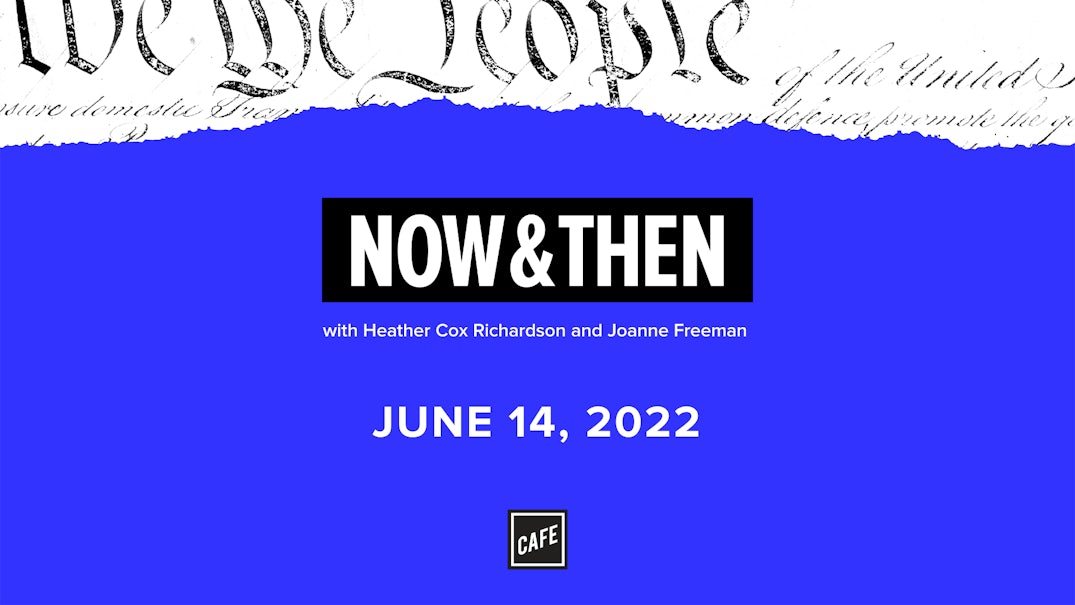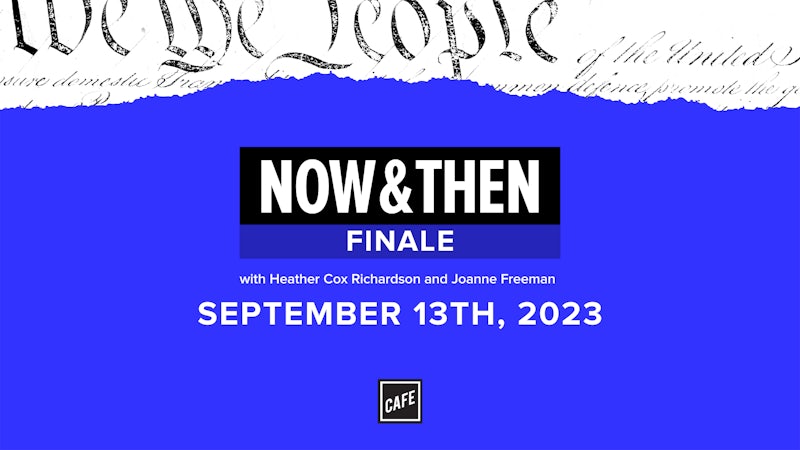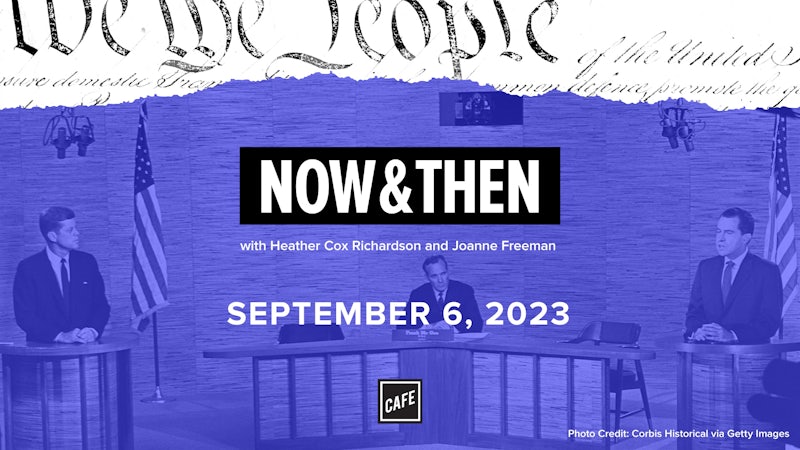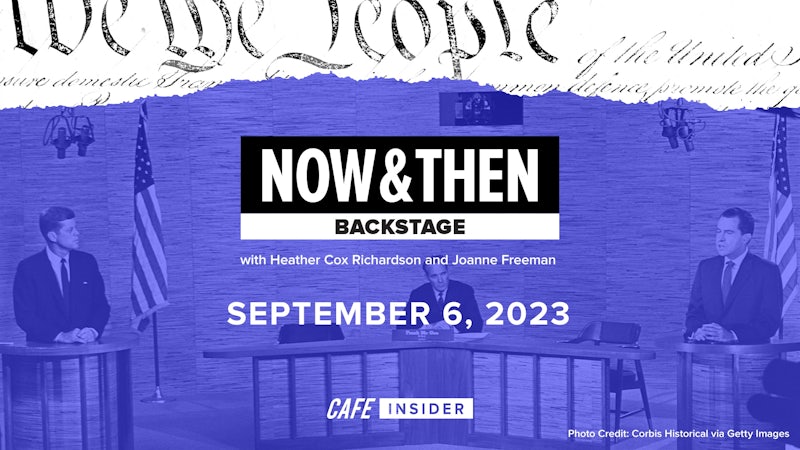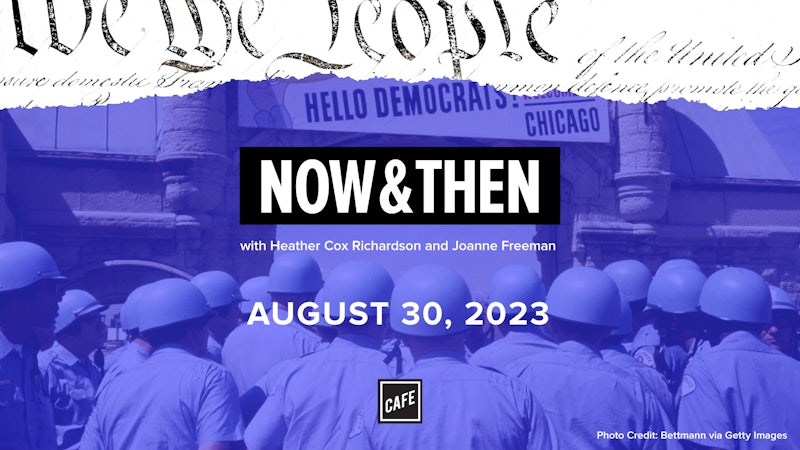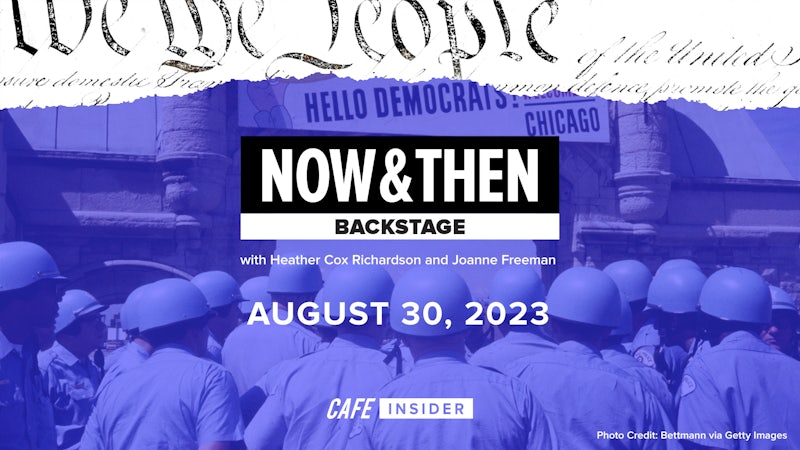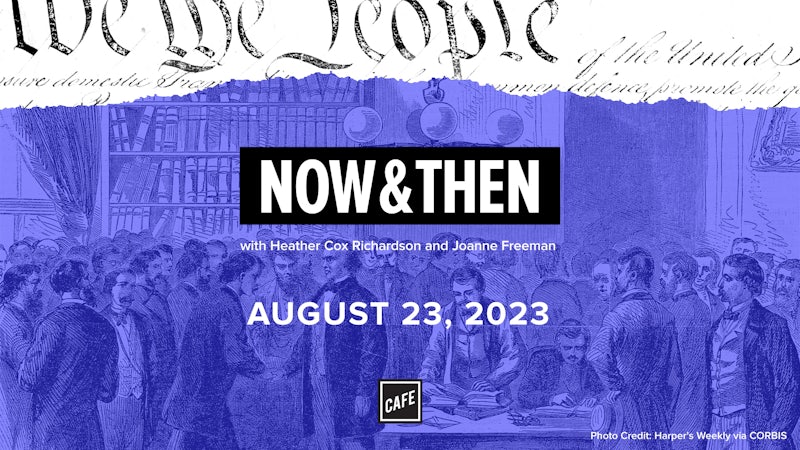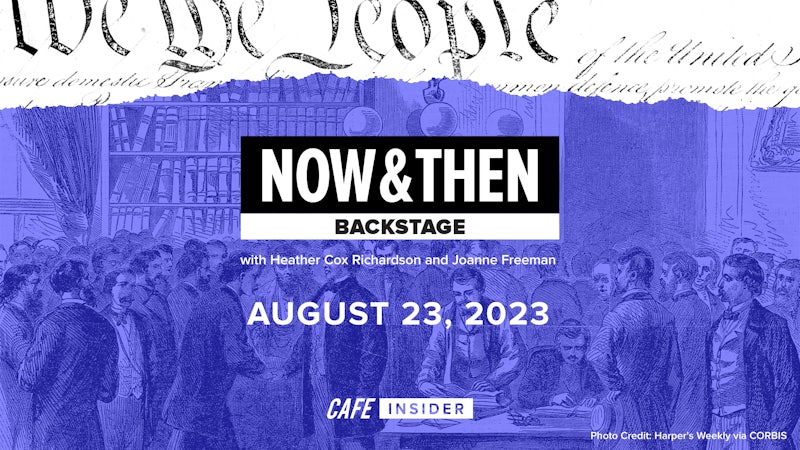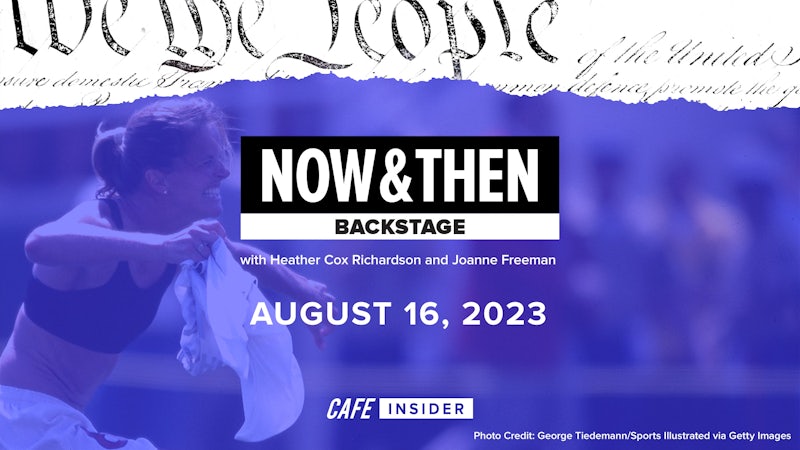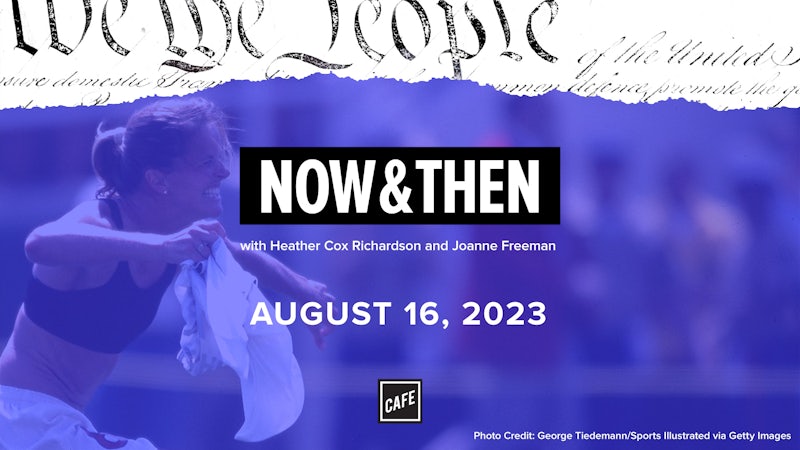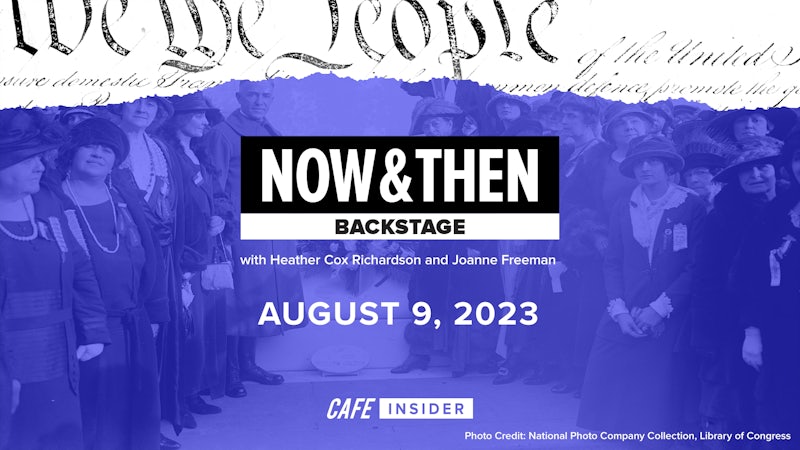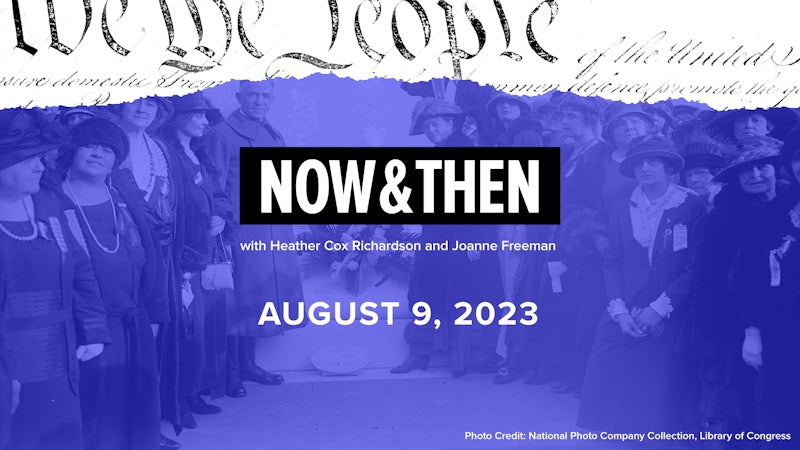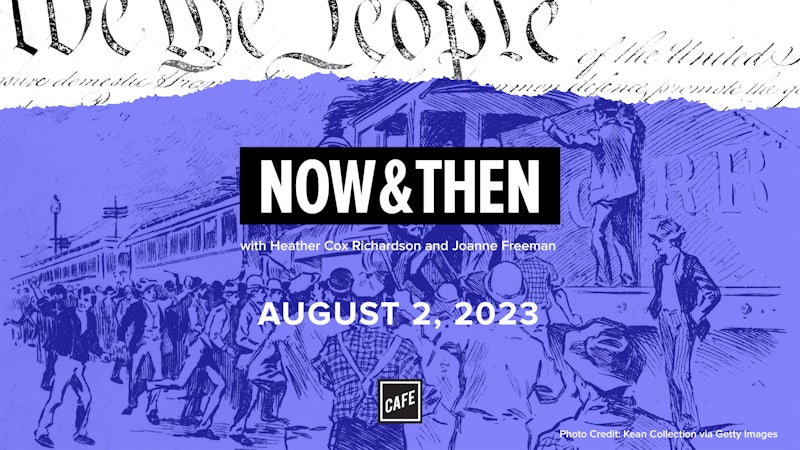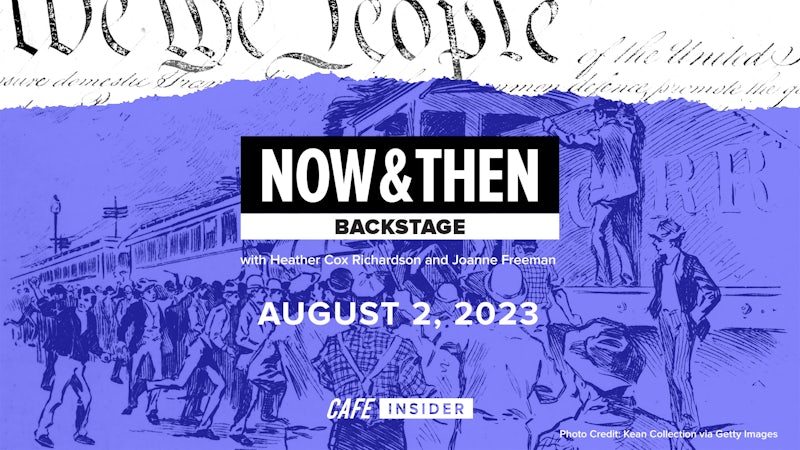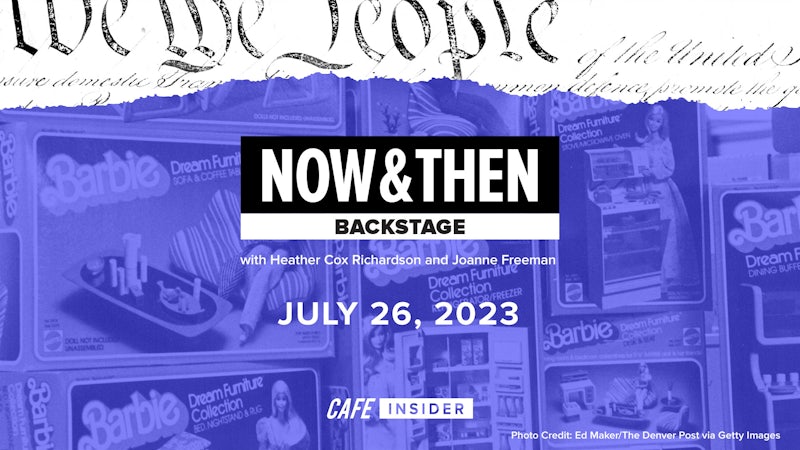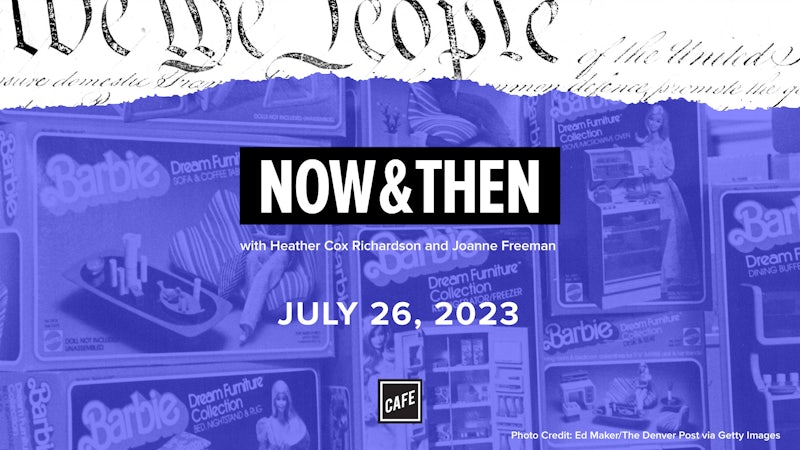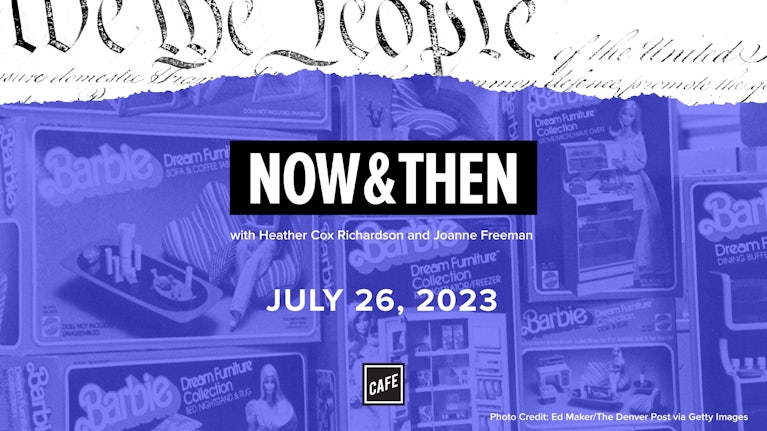Heather Cox Richardson:
From CAFE and the Vox Media Podcast Network, this is Now & Then. I’m Heather Cox Richardson.
Joanne Freeman:
And I’m Joanne Freeman. Today’s topic, in a sense, will make perfect sense once I state what it is and why it came to our minds. What we want to talk about today is nostalgia. And the reason that that came to mind in part is because we’re at this weird moment where there certainly seem to be a lot of people looking back in time at some ultimately non-existent, perfect, wonderful past, at least according to the feelings and views of the people looking back in that direction that they want to go back to, this wonderful past when things were different.
And Heather and I were talking about this before, one of the things that came up with the theme song to All in the Family, which has a line in it like, “And you knew who you were then. Girls were girls and men were men.” (singing). This golden past that right now, some people are politicizing and seemingly almost using as a basis of policy. So, we want to talk about nostalgia.
We want to talk about different times in American history when in one way or another nostalgia really played a prominent role. So, we don’t want to simply drift and think, “Ah, yes, nostalgia for the past.” We want to talk about how it was being used in the past and what that suggests about the politicization of nostalgia and what the past might reveal about its deployment today.
Heather Cox Richardson:
Well, I do think it’s interesting that the line after “Girls were girls and men were men,” is “Mister, we could use a man like Herbert Hoover again.” (singing). And you think about that, Herbert Hoover was not a shiny example of a president who did everything exactly right. I mean, basically, they’re saying, “Hey, let’s go back to the 1920s,” which didn’t end up very well and certainly didn’t seem to serve a lot of the people that were in America at the time, aside from those like Archie Bunker.
I also think it’s worth, before getting into this topic, thinking about that we at least, I anyway, think nowadays about the negative ways in which nostalgia has been used. So, for example, one of the people running for governor in Pennsylvania, Doug Mastriano, talked about restoring the dream of Pennsylvania, a place where you want to come and live.
Doug Mastriano (archival):
And so, we’re going to take the state by storm. We’re going to restore freedom and liberty. We’re going to remember what our founding fathers, all of which spent time in Pennsylvania and Philadelphia creating this beautiful nation that we have, the founding documents, all founded upon the belief that all men are created equal and that we have the right to life, liberty, and the pursuit of happiness. We’re going to get back to basics.
Heather Cox Richardson:
And so on and so forth about this idea of the past as this place that embodies what in his mind is quite a far right-wing dream. There’s also the other side of them, which nostalgia can be used by politicians and that’s just a very positive thing. So, for example, Barack Obama, very famously in 2015 when he was commemorating the 50th anniversary of the Selma March to Montgomery, talked about American history as being one in which people worked to make the principles of America come to life.
So, he talked about struggling for a future rooted in the past and used the past as a way to talk about the principles of struggling to create a better future.
Barack Obama (archival):
We respect the past, but we don’t pine for the past. We don’t fear the future, we grab for it. America is not some fragile thing. We are large, in the words of Whitman, containing multitudes. We are boisterous and diverse and full of energy, perpetually young in spirit.
Heather Cox Richardson:
So, nostalgia, it seems to me, is less about simply pining for the past because you want to create a certain kind of right-wing future or American future. It’s a really complicated idea about what we are saying about American society when we do try and frame our present through the way we look at our past.
Joanne Freeman:
Exactly. In a way, what nostalgia is, far more than the past, is a statement about people’s views and feelings about the present.
Heather Cox Richardson:
One of my favorite things about nostalgia when we talk about it is the fact that nostalgia was actually first a term that was coined in a medical dissertation in 1688 by a Swiss physician who combined the words for homecoming and pain. And what he was looking at primarily was how soldiers, who were taken away from their homes, got very sad about leaving their home and the people that lived in their home behind.
And by the 18th and the 19th centuries, the French doctors especially have pathologized the idea of nostalgia. They even go so far as to think it comes from a certain bone and they look for that bone in people. And they try and cure nostalgia by purging people’s stomachs, by giving them baths, and through leeches.
Joanne Freeman:
Always leeches-
Heather Cox Richardson:
It’s always leeches.
Joanne Freeman:
… the name of disease. It’s always bleeding or leeches. So, that makes perfect sense. So, indeed, when nostalgia comes along, it’s linked with pain, that there’s kind of a pining component for it. And yet in modern times, there’s a pleasure component to it, right? That you’re thinking fondly of the past, you have nostalgia, you have fond feelings. So, that’s interesting in and of itself that I think it can veer either way.
Now, when we first started talking about this, the first thing that both you and I said at the same time was jeremiads, jeremiads. Jeremiads or the way that we’re going to be talking about them is going all the way back to the Puritans. A Puritan jeremiad was basically a style of sermon that stated that the Puritans had come to the colonies and started out as this golden place blessed by God.
And that there had been a backslide or declination from that point and that something needed to be done so that people needed to cleanse their ways and prove their ways so that the Puritans themselves could move back towards something that was better, could redeem the promise or the mission of being a Puritan.
Heather Cox Richardson:
What I love about this is these are Puritans who have come to America as part of the great migration from 1630 to 1640, and then thereafter. And they’re talking about how badly things have gone since they arrived, how badly their society has declined, how much better things were in the past. And they’re writing in 1670. I mean, it’s not anything new for Americans to go, “Man, things were better in the past.”
But here is the thing about that and that’s actually significant because ultimately, are they really talking about this vast downslide in morals and behavior? Or are they using jeremiads as some kind of a tool as a way to define their social order and as a way to suppress internal conflict?
Heather Cox Richardson:
I know exactly. See, I can tell exactly what you think, Joanne.
Joanne Freeman:
Okay. Maybe I shouldn’t ask it as a question, but I think it’s a significant point, right? It’s not as though the Puritans were like, “A drift in a sea of sin.” That’s how they’re depicting it. But they’re doing that in these sermon-like orations, which often are given not necessarily in a service at church, but in public events of various sorts. And usually, public events then are sponsored in one way or another by authorities.
They’re standing up in front of the community and essentially saying, “We came here with a mission. We’re failing in the mission. We need to get back on track so that we’re fulfilling the mission.”
Heather Cox Richardson:
So, do what I say.
Joanne Freeman:
Social control, right? So, it isn’t like explicitly really at its heart about an absolute conviction that everything has gone to hell and we’re all done for. It’s like perhaps there’s some of that mixed in there, but a huge component of the energy behind these jeremiads is the sense that you have to define and cohere the community. You have to get it to act in a certain way, and that that’s the only way you’re going to be able to go back to the original mission of the Puritans.
And I want to give you a sense of what this sounds like in practice. Here is a sermon by Samuel Danforth called… I love these wonderful 17th and 18th century titles, which go on and on and on and on and on. When you’re making footnotes as an undergraduate, trying to fill pages, the titles of these fill footnotes endlessly, you think “Yes, another early American pamphlet that has a five-line title.”
This, by Samuel Danforth, is called A Brief Recognition of New-England’s Errand into the Wilderness from May 1670. And Danforth says, “But who is there left among you, that saw these churches in their first glory, and how do you see them now? Are they not in your eyes in comparison thereof, as nothing? How is the gold become dim? How is the most fine gold changed? Is not the temper, complexion, and countenance of the churches strangely altered?”
“Doth not a careless, remiss, flat, dry, cold, dead frame of spirit grow in upon us secretly, strongly, prodigiously?” So, you can tell along the lines of what we were just saying, Heather, right? 1670, oh, the gold is doom. We’re fading, we’re sinking away. And that string of adjectives, careless, remiss, flat, dry, cold, dead, really trying to drum home for people that it’s not quite nostalgia as, “Oh, yes, the past.”
Joanne Freeman:
This is the pain version of nostalgia, right? Look at where we were and look at where we are.
Heather Cox Richardson:
Well, there is I think in the jeremiads, though, a really important component of the concept that these Puritans anyway were God’s chosen people. So, even the idea of a jeremiad comes from the Bible, from the Old Testament prophet Jeremiah, who argued that the kingdom of Judah was going to fall because it had fallen away from its original religious purpose. So, when somebody like Danforth talks about the errand into the wilderness, they are really harking back to God chose us.
Joanne Freeman:
Well, and we are on a mission. God chose us. We are the chosen people, and we have a mission to fulfill as the chosen people.
Heather Cox Richardson:
There is also, I think, that sense that if they cease to live at the level that they expect to, that God might ignore them. This is not so much about, “Hey, we’re not misbehaving so much as, oh crap. What if God stops treating us well? What if we end up being in real trouble because we’re not doing as God says?” And then, there’s another aspect of that I think as well and that is what if we were wrong altogether? What if God is silent? What if we weren’t special after all?
We got to prove we’re special. We got to work harder and harder to prove we’re special because if we don’t, maybe we’re not special after all. Maybe we’re just a bunch of guys from England who came over and took the land away from the indigenous people.
Joanne Freeman:
But think about what that says again, as we suggested a few moments ago, about the current mindedness of the Puritans, right? That they are worried that they’re lapsing. They’re confused about what’s going on. What are they doing? Are they doing what they’re supposed to be doing? And so, they’re looking back and making a direct comparison. As you say, the children of Israel went into the wilderness to serve God.
And here we are doing the same thing in a new wilderness that it isn’t just a glorification of the past. What it says more than anything else, it shows the anxiety and unknowingness of the position that these people are in. And they’re grabbing at the past as a way to understand and maybe cohere the present and push it into a future that they would like, that they would envision. So, they’re using nostalgia.
They’re grabbing at it in a time of confusion where they feel that it can help them make points, drive ideas in a direction that they feel that they must be so that the future will look like they want it to look.
Heather Cox Richardson:
And I think it’s important to clarify that when you say they, that’s the Danforth’s and the Increase Mather’s and the ministers who are running the colonies and who are starting to worry about these other people who seem to care about making money, and wearing nice clothes, and maybe are spending a little bit too much time hanging out with non-Puritans. That if they keep saying, “If we just go back to the way we were way back there in the past 20 years ago, everything is going to be okay. So, do what I tell you to do.”
Joanne Freeman:
The idea of nostalgia used through the jeremiad as a way of grasping at the past at a time of concern about the present.
Heather Cox Richardson:
Yes. And the idea, too, that you’re proving that you’re great, you were always great. But your point that there’s anxiety in these is really important because yeah, the past was so great, and maybe we weren’t as special as we thought we were.
Another emphasis on nostalgia that jumped out to both the two of us, the next one is a very famous reunion in American history and that’s the Gettysburg reunion, a very famous reunion of a number of the men who had fought at the Battle of Gettysburg that was held in 1913.
So, the backstory to this is that the Battle of Gettysburg is fought during the Civil War between July 1st and July 3rd of 1863, fought between the US army, the Army of the Potomac, which was commanded at the time by General George Meade, and the Army of Northern Virginia for the Confederate states of America, which was commanded at the time by Robert E. Lee. This was the famous Gettysburg battle.
The north wins, and the Confederacy takes such extraordinary hits. It’s really not going to recover. Between the two armies, there were about 50,000 casualties over the course of those days. Really horrific battle, that’s why we get the National Cemetery at Gettysburg. And in April of 1908, there is a move of foot to bring back the soldiers on both sides of the battles to have a reunion at Gettysburg.
And one of the people who went to bring the two groups back together was a veteran who had fought in the 150th Pennsylvania who had lost an arm at Gettysburg. So, he decides to do this in April of 1908. And in 1909, there’s a planning committee that meets with President William Howard Taft to formalize a plan for a meeting of the 50th reunion of the battle at Gettysburg. The war department subsidizes this reunion, and it’s a really big budget. It’s the equivalent of $31 million today.
And about 54,000 of the surviving Civil War veterans attended the 50th anniversary reunion. There were about a half a million Civil War veterans left alive at the time. They had about 5,000 tents. They covered 280 acres in the middle of a battlefield, which is really quite a huge battlefield that stretches for more than a mile. There was a big central tent that had almost 14,000 seats, and there were speeches every day.
And at the end of the day, there is a very heavily orchestrated reenactment of 150 Confederates who represented the original 15,000 Confederates reenacting Pickett’s Charge. And Pickett’s Charge was the climactic event of that battle. It was the Confederate assault on the Union lines, in which the Union troops held back their fire until the Confederates were all hideously exposed in the middle of the field and then opened the artillery on them and basically wiped them out.
So, the veterans charged at the stone wall, which was the High Water Mark of the Confederacy on that day. It’s at a place called the Angle. And they charged to the stone wall up to that place. And then, they stopped and they reached across the stone wall marking the Angle and they shook hands with 180 survivors of the battle from the Union side who had been in Webb’s brigade, which had been standing there. It’s 50 years before. They shook hands.
The United States soldiers passed to each of the Confederate soldiers a silk of American flag. So, this is a really major moment of pageantry and of recollection of what had happened 50 years before. But of course, yeah, but. We always go with the but.
Joanne Freeman:
There’s a but. Immediately, I had to think of that when you kept saying they, they did this and they did that. And of course, the big question here, and generally I think when you’re talking about nostalgia is, who is the we that you’re talking about? Who is included in that nostalgic vision of the past? So, this does have a lot to do with who the we is. You kept saying they.
And a really obvious question here is, in all of this reconciliation and handholding and flag passing, who exactly is saying what to who and who isn’t in the picture? So, an example of this question being front and center has to do with a speech that takes place during this reunion made by Bennett Young, who’s the commander of the United Confederate veterans. First, he led former Confederates in a rebel yell.
He called on Union soldiers to respect the construction of Confederate monuments. Boy, you can just never stop talking about Confederate monuments. And then, he said this, “You had great soldiers. You had hundreds of thousands of men whose hearts were touched with the truest instincts of patriotism. Build them monuments wherever you will. Load their courage and their virtues as you may.”
“Write in unnumbered volumes the story of their achievements and enshrine in your hearts the sacrifices of the millions who fought and fought as you fought and fought. We only claim the same right as to our dead comrades.” Now, he’s talking about Confederates there. “We, who fought a war against the United States, we deserve the same kind of respect and the same kinds of thoughts as others. And these statues are one way of guaranteeing that.”
Now, not surprisingly, given that the few Black veterans who attended the reunion were not necessarily participating in that kind of rhetoric. They didn’t get much coverage generally by the national press, but the Black press had a lot to say about that kind of message, not only of reconciliation, but of celebration of the Confederates.
Even beforehand, in the May lead up to the event, the Washington Bee argued that ex-Confederates were using the occasion of the reunion to wash their hands of their defense of slavery. As the newspaper put it, “The occasion is to be called a reunion! A reunion of whom? Only of those who fought for the preservation of the Union and the extinction of human slavery?”
“Is it to be an assemblage of those who fought to destroy the Union and perpetuate slavery, and who are now employing every artifice and argument known to deceit and sophistry to propagate a national sentiment in favor of their nefarious contention that emancipation, reconstruction and enfranchisement are dismal failures?” So, whose reunion and what is the message being spread by the reunion? Very blunt, open and logical questions being asked in the Black press at the time.
Heather Cox Richardson:
And The New York Age said, “Look at what you’re presenting to the world.” The editor is talking about the people who are actually at the Gettysburg battlefield. He said, “The mock lovefest at the Gettysburg celebration did not conceal the skeleton in the national closet.” And it says that some of the Black soldiers who were there said that there was constant fighting between the US army soldiers and the Confederate soldiers.
And that a lot of the reconciliation was really media. I mean, it’s really a put-on for the political needs of people like Woodrow Wilson, who at the time was president and who after the reunion said, “We have found one another again as brothers and comrades in arms, enemies no longer, generous friends rather, our battles long past, the quarrel forgotten, except that we shall not forget the splendid valor.”
And it’s pretty clear, someone’s getting thrown overboard in this vision of what the happy past looked like. And that, of course, would be the Black veterans and those who fought the Civil War to end human enslavement and to enshrine the Declaration of Independence into our national life in a way that it never had been before.
Joanne Freeman:
It’s also worth noting that this criticism from the Black press and this moment is happening at a time of particular violence toward Black Americans. There were at least 64 lynchings in 1912 and at least 51 in 1913. So, the phrase that you read a little bit back from the New York Age about the mock lovefest not concealing the skeleton in the national closet is very true.
And you can see it in the current day happening all around people, so that there’s this pageant sort of hearkening back to a moment that they’re acting out of battle, but they’re not really hearkening back to the violence of it, or the brass tacks reality of what’s being fought over, or how they’re making it a wonderful moment of reunion when everyone can come together and praise the Union and celebrate valor. And that’s that.
Heather Cox Richardson:
It’s interesting you say that because one of the things that a reporter says is that when US veterans heard the rebel yell, and imagine hearing that yell on the same ground that you had heard it 50 years before while your friends were dying all around you, they did not cheer. They stood there in silence when they listened to the rebel yell.
But interestingly enough, after the Gettysburg reunion, Boston veterans organized a different reunion to honor the Battle of Fort Wagner in South Carolina, which also took place in July of 1863. And that’s the battle that’s immortalized in the movie Glory. And that’s the charge of the Massachusetts 54th, which was an all-Black unit against the fortifications at Fort Wagner that ended up with that Massachusetts 54th losing half of its troops.
So, in that commemoration held after the Gettysburg won, both Black and White soldiers went. And there were a number of people from the Massachusetts 54th or associated with the Massachusetts 54th. They had a memorial for the leader of the 54th, who was Colonel Robert Gould Shaw, as well as for the governor of Massachusetts during the Civil War, John A. Andrew, who had commissioned the unit in the first place.
They laid reeds at the statue of Andrew and at Shaw’s memorial. They sang songs like The Battle Hymn of the Republic. And they quite deliberately excluded Confederate perspectives and talked about the United States of America as one that had been supported 50 years before by US army soldiers and not by both US army soldiers and the Confederates.
Joanne Freeman:
So, echoing those ideas, Frank Fay Young wrote an op-ed for the Chicago Defender about that Fort Wagner celebration and talked about the fact that Bostonians recognize the need to exclude Confederate perspectives and to really highlight the role of abolition in the conflict. He wrote, “With the country taking an interest in elaborate celebration of the 50th anniversary of the Battles of Vicksburg and Gettysburg to the south of us, Boston and Massachusetts intend the semi-centennial of an equally pivotal battle in one sense that of Fort Wagner shall not be neglected.”
“There was no reading of the stars and bars under which soldiers went out to war to destroy the United States and to perpetuate slavery. The spirit of the celebration was that of freedom and equality in all things for the class of Americans whose liberty and equality were won by that war and are now being abridged.” That’s nostalgia with a point.
Heather Cox Richardson:
Yeah, but it’s also just so wonderful. I mean, that’s really the commemoration of what Gettysburg was really about. And yet, I find it fascinating when we’re talking about nostalgia that, well, many people know about that very famous 50th anniversary of Gettysburg. You can find pictures of that. You can even find posters of that, of the veterans shaking hands across the stone wall at the Angle.
The 50th commemoration of Fort Wagner is far less known. Even in our nostalgia, we have picked what kind of our past we’re going to wax nostalgic about.
Joanne Freeman:
We’ve picked who we are including in the we of our nostalgia and who basically we’re either excluding or just not considering.
Heather Cox Richardson:
And not allowing to have a foothold in our past. Again, you’d think about this, you’d think you’d be remembering the Fort Wagner reunion and not the Gettysburg reunion.
Joanne Freeman:
Now, this brings us to yet another category of nostalgia that, again, we settled on pretty quickly because it was so assertive, so aggressive, so buried in American culture and something that the two of us have memories of as well. And that is the nostalgia in the 1970s for the 1950s. Part of the reason for it, I would assume, is because of some of the chaos of the early 1970s where you had Nixon’s impeachment, and you had the Vietnam War, and other kinds of unrest.
And that along the lines of what we were saying earlier, that if there’s a moment of unrest, if there’s a moment when people feel unsettled, when they’re not sure of where they’re going, it makes sense that one of the things they might do is grab at a past, a past that probably never existed but a past that gives them a sense of a we, of who they, or some people want America to be. And in the case of, I think, the 1950’s nostalgia, a way of not thinking really about politics very much at all.
Heather Cox Richardson:
Well, a way to align politics. So, you talk about the early 1970s, and Nixon, and stagflation, and all that, but 1968 looms so huge. I was thinking about ’68 just the other day as one does while I was driving. It starts with the Tet Offensive, when Americans have to come to grips with the idea that they are not in fact winning in Vietnam, the way that the president had been assuring them.
And then, in April, you have the assassination of Martin Luther King, Jr. And then, in June, you have the assassination of Robert Kennedy. It just goes on and on and on. And then, by the fall of ’68, you’ve got the chaos in Chicago with Democratic National Convention. ’68 is sort of like, “Oh, crap. What’s coming next?”
Joanne Freeman:
It’s a drumbeat of death and conflict that just doesn’t let up.
Heather Cox Richardson:
But it’s always interesting too, because when we think about nostalgia and looking backward, as we’re talking about people reaching backward to the 1950s and the way that they really do this initially is through music. The same period we’re talking about is extraordinarily creative for music. There’s all kinds of new, incredibly exciting, amazing bands, amazing sounds, new combinations in this very period. And yet-
Joanne Freeman:
And yet, the people who we thought of when we began talking about this, Sha Na Na. How can you not think about Sha Na Na? And what’s interesting now that you highlighted 1968, their first real performance is 1969 at Woodstock, the first noteworthy performance. So, it’s right around that time. And two of the people who created the group explicitly make the connection that we were just making.
And say, “In 1969, most of Columbia had been through a year of the riots, fist fights, and broken friendships of the revolution. Alumni will remember the morning sounds of glass being chipped from last night’s broken windows onto the sidewalk, the tinkling mixing with the drone of a bullhorn echoing Off Low Library’s steps.” So, these people who were part of an acapella singing group at Columbia University are the ones who come together and create Sha Na Na.
In part, very deliberately looking back to a past that in some way represents the opposite of that present that they were recalling when talking about the founding of the group.
Heather Cox Richardson:
And there’s a wonderful juxtaposition when they do perform at Woodstock. They actually performed just before Jimi Hendrix goes on with his closing set, where he performs The Star-Spangled Banner in that extraordinarily innovative and shocking at the time way. I mean, he’s indigenous and African American, and he is doing things on an electric guitar that nobody could have imagined before that. And just before that was Sha Na Na.
Joanne Freeman:
Sha Na Na. And to remind you, what they’re performing are songs from the ’50s, like At the Hop. I mean, so it’s not even like they’re fake looking back and remaining in the present. Sha Na Na had a number of original songs. But what they were mostly known for, and there were very many original songs, what they were mostly known for redoing songs from the ’50s in a hyped-up way.
But very much, it was the ’50s that was up there performing. What a juxtaposition, you’re right. The members of Sha Na Na commented actually, very particularly about that juxtaposition and how weird it was. They said, “Everyone had long hair, love beads, and tie-dye. They stood around the mics and sang. When we burst onto stage,” he’s talking about Woodstock, “greased, in gold lame, doing George’s Busby-Berkeley-Goes-Apollo dances, a quarter of a million freaks probably thought they’d taken the wrong acid.” Pretty much sums that up.
Heather Cox Richardson:
And yet, there was obviously great cultural power in what they were doing, recalling an older time, again, inaccurately recalling an older time. By July of 1972, that look back at the 1950s had turned into the musical Grease, which opened on Broadway. It was set in 1959 at a fictional high school and it involved a romance between the bad boy and the good girl. And it was such an immediate, an astonishing success. It got seven Tony nominations and it ran continuously until 1980.
Joanne Freeman:
Which is pretty remarkable. Actually, even just recently, there’s been a series of musicals for a while at least that were being redone live on network television. And they redid Grease and apparently, the ratings were great. So, people are still really cheering on this musical that is very much about the ’50s, bad boy, good girl, how they come together.
Actually, Sha Na Na is in Grease. The music very reminiscent of what we’ve been talking about.
Heather Cox Richardson:
And the play, of course, became the movie Grease with Olivia Newton-John and John Travolta. That became the highest grossing musical at the time. And the soundtrack album from that film ended 1978 as the second best-selling album of the year coming in behind the Bee Gees. The soundtrack from another Travolta vehicle, which was Saturday Night Fever.
Joanne Freeman:
Which is so much of that moment. When you watch that-
Heather Cox Richardson:
I’m dying here because I can tell you, speaking of nostalgia, I know exactly where I was and when it was that I saw Saturday Night Fever.
Joanne Freeman:
Wow. I cannot say that. I just can say that when it comes on and I happen to be seeing it or part of it, it sucks you into a vortex of the 1970s. It’s like, “Help, I can’t get out.” It’s just the clothing, the attitude, the hair, it’s almost like a time capsule.
Heather Cox Richardson:
So, the extraordinary backlash to the 1960s and the early 1970s, by reaching back to that allegedly happier period, became quickly a whole cultural moment. So, we have the filmmaker George Lucas tapping into this nostalgia for the 1950s by writing a new screenplay called American Graffiti. It’s set in 1962 and it is sort of an ology, if you will, for the fading 1950s.
It’s a group of high school graduates who are having a final send-off before they head back east to college. And the film introduced a number of actors who become iconic for their era. That’s Richard Dreyfuss, Ron Howard, Paul Le Mat, Harrison Ford, Charles Martin Smith, Cindy Williams, Candy Clark, Mackenzie Phillips, and Bo Hopkins. And it also introduced a whole new generation to-
Joanne Freeman:
Wolfman Jack. You have to say it that way. The disc jockey, Wolfman Jack.
Heather Cox Richardson:
So, that opened in August of 1973. Lucas had produced the movie for about $777,000. But by the time its first run was over, it had made $55 million. That’s something that is tapping into the public consciousness.
Joanne Freeman:
Pretty amazing. And that’s a very clear measurement, which is the amount of money that people are willing to fork over.
Heather Cox Richardson:
To remember a happy version of their past. But now, here we go. Here we go. I’m doing this for all our listeners. The soundtrack of the album reached number 10 on the Billboard 200 Album Chart. It included songs like, and I’m going to say the songs and Joanne is going to sing the first lines.
Joanne Freeman:
Oh, boy.
Heather Cox Richardson:
Rock Around the Clock.
Joanne Freeman:
We’re going to rock around the clock tonight.
Heather Cox Richardson:
Sixteen Candles.
Joanne Freeman:
Sixteen candles. I have to tell you, I did not prepare for this.
Heather Cox Richardson:
I know. I know. I didn’t let you… I didn’t give… okay, okay. Runaway.
Joanne Freeman:
Oh, I think that’s my little runaway.
Heather Cox Richardson:
Okay. Why Do Fools Fall In Love?
Joanne Freeman:
Oh, man, I know that one. Is that why do fools fall in love?
Heather Cox Richardson:
And finally, That’ll Be The Day by Buddy Holly and The Crickets.
Joanne Freeman:
Oh, that’ll be the day. Okay. So, now I have to say, normally, I’m good on pop culture TV commercials and theme songs. The fact that I could actually do that, and I’m not someone who has a big connection with 1950s music, Heather, you have given me my sense of accomplishment for the day.
Heather Cox Richardson:
It was actually somewhat making a point that you and I both could do that now because we grew up in this period, and you could not get away from that music and from that whole moment. So, George Lucas actually identified this, as we have been doing so, by saying, “I became very aware of the fact that the kids were really lost, the sort of heritage we built up since the war had been wiped out by the ’60s. And it wasn’t groovy to act that way anymore.”
“Now, you just sort of sat there and got stoned. I wanted to preserve what a certain generation of Americans thought being a teenager was really about, in a strong sense from 1945 to 1962, that generation. There was a certain car culture, a certain mating ritual going on, and it was something that I’d lived through and really loved.” And again, who’s doing that… I know exactly what you’re going to say.
Joanne Freeman:
We’re talking about American Graffiti, and we’re talking about Grease, and we’re talking about Sha Na Na. And those are all… if you’re looking back to this past that’s making people happy, it’s a pretty White middle class past. It’s a very specific past.
Heather Cox Richardson:
And heteronormative. And heteronormative.
Joanne Freeman:
Yes, yes. So, if you’re talking about the we in this case, who’s included in the, ah, yes, the good old days? That’s who’s looking back to it and that’s what their good old days look like.
Heather Cox Richardson:
Well, I wonder sometimes, when you hear politicians on the right nowadays talking about how great the 1950s were, if this is what they’re thinking about. That they’re thinking about this constructed past from the era in which a lot of them grew up. And then, after American Graffiti had been so extraordinarily successful, ABC developed a new sitcom, starring Ron Howard as a 1950s teenager from Milwaukee named Richie Cunningham.
Joanne Freeman:
Happy Days.
Heather Cox Richardson:
Go ahead. Let’s hear the theme song.
Joanne Freeman:
Oh, I only know a little bit of it. Sunday, Monday, happy days. And then, I can’t go on.
Heather Cox Richardson:
That starts in January of 1974. It runs for 11 seasons. It’s the same kind of happy story of the straight-laced teenager, Richie Cunningham-
Joanne Freeman:
And his friends.
Heather Cox Richardson:
… who makes friends with the bad guy, played by Henry Winkler who’s Fonzie, and the parents, and they live in this sort of middle class, White home. And from that, there was one spinoff after another. There was Happy Days, then there was Laverne & Shirley, starring Penny Marshall and Cindy Williams. We get Mork & Mindy actually comes from that.
And finally, Joanie Loves Chachi, which only lasted two seasons after it debuted in 1982, suggesting, first of all, that it wasn’t the same kind of writing or acting but also that that moment in American nostalgia had run through.
Joanne Freeman:
I have to make one total trivia point about Happy Days, which maybe everyone knows. But if they haven’t, then they will probably appreciate this. The phrase that people sometimes use that a series, a TV series or something has “jumped the shark” that has just gone too far. It’s over the edge. It’s way over exaggerated. So, the phrase “jumped the shark” actually comes from Happy Days.
And it comes from late in the run of Happy Days when they were clearly running out of things to do and plot lines. And so, at some point, and I haven’t seen that episode in a hundred thousand million years, but at some point, there’s an episode in which Fonzie, I believe he’s on water skis, jumps over sharks. And that phrase “jump the sharks” comes from wooh, okay, that series had pretty much just ended its time.
It pretty much came to a close in reality and having anything to do with reliable plot lines when Fonzie jump the sharks. But talking about jump the sharks, related to what you were just saying, as happens in popular culture, it’s one after another, after another, after another gets spawned from an original hit. But again, although there are slight variations, there really is, for the most part, this White middle class, as you said, heteronormative image of the past with parents who are present.
And even the bad boys like Grease or Fonzie, they’re very nice bad boys. They’re basically on the edge of already fitting in. So, it’s a very polished, very contemporary, very golden, romanticized past. You said a little while back that maybe some politicians on the right today are thinking of that when they’re talking about this past they want to go back to.
I would be even a little bit harsher about it and say, maybe they’re assuming that the public has that image of the past when they’re hearkening back to the golden ’50s and all of the good old times, the good old TV shows, and the good old values, and girls are girls and men were men, and everything else associated with that period. Maybe some on the right who are politicians assume that, but they certainly know that that image is a powerful image in American culture.
And that if they use that image, it’s going to have an impact. Now, that leads to another point, which is to what degree does that image actually line up with what their image of the future of the United States should be. We talked about, when we started out, how nostalgia often represents people who are in a state of unsettlement, unrest, who are reaching back to a past to give them a sense of comfort in the present and to guide them and guide others into a future that looks the way they want it to look.
If you think about all of the stories that we’d told today, in one way or another, about nostalgia, you can see that happen again and again. It sets our current moment and the politics of this moment and the ways in which people repeatedly talk about this weird, non-existent past that particularly people on the right keep hearkening to and highlighting and pitching as the glory moment of America. As with most nostalgia, it never existed.
That moment didn’t exist. The moment that they’re celebrating is an image of what they might want America to be, an image that they know will play well in the present, but it doesn’t necessarily represent an accurate view of the past.
Heather Cox Richardson:
I think of it like Happy Days, for example. I think of them as flat images of the past that talk about how absolutely wonderful one period or another was. I think of them like The Hardy Boys or like the Nero Wolfe novels, where you don’t have to think very hard because the characters all are, once you know, they all behave in certain ways. And there’s very little new material. It’s just very comforting to read these things.
But the thing that I find interesting about the sorts of nostalgia we’re talking about that are not rooted in reality the way, for example, that the Fort Wagner Memorial was, is that who wants to read The Hardy Boys all day? It’s fun, it’s entertaining but it’s like paper dolls. Paper dolls are really important for a certain part of people’s development because they’re figuring out categorizations and all sorts of things that developmental psychologists say the kids need paper dolls for.
But I am really much happier living in a world in which people are three-dimensional and actually do things and actually don’t behave in really formulaic ways. I do think that the nostalgia is almost like a formula or, here’s our word again, a cajole for shaping the present. But it can also be, depending on how you remember like the Fort Wagner people or like Obama did with his Selma speech, a way to say not that we want that Hardy Boys version of the past so much as we want those values to be embodied in the present in new, exciting living ways.
Right. I think that’s important to note here, basically, is what you’re saying in one way or another is, yes, you can look back to pick a moment in the past and shine it up and make it all polished and wonderful and be nostalgic for it. It’s possible to be nostalgic for parts of the past and not for others. It’s possible to look back and see certain things as good and worth remembering and it had merit, while readily acknowledging that there were many, many other things that didn’t and that need to be remembered alongside the things that we might feel positively towards.
Nostalgia can be complex. It can have subtleties, right? It doesn’t have to be polished and shiny. And I think we’re at a moment, particularly given that things feel so unsettled, there isn’t a lot of subtlety. There aren’t a lot of gradations in what we’re thinking about things at the moment and particularly the way nostalgia is being used right now. But it doesn’t have to be used that way. You don’t have to throw out the past entirely as being unconnected and you don’t have to swallow it entirely either.
Nostalgia is a way of thinking about the past and you can do that, I think, in an intelligent way, allowing the complexity of the past to be present in full.












